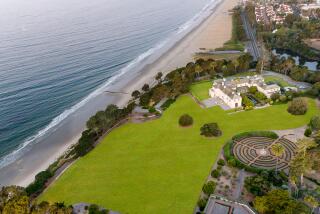Lost L.A.: Huntington’s private tribute to wife Arabella
- Share via
Power, money and love fuel extravaganzas. Railroad millionaire Henry E. Huntington had all three and used them in the closing decade of his life to build his eponymous San Marino library and gardens. You know the mansion, the cactus and the Japanese tea house. What you may not know is that Huntington’s estate once had a gallery dedicated to his wife, Arabella.
Known as Belle, she probably was born in Alabama, and through brains and charm she became the mistress of Collis P. Huntington, financier demon of the Central Pacific Railroad. When his wife died, Collis married Arabella and together they led a glittering life of private rail cars and big houses, including one at 57th Street and Fifth Avenue in New York where the jeweler Tiffany & Co. is today.
At his death in 1900, Collis was among the 30 richest people in the U.S., notches down from John D. Rockefeller. Collis left his gazillions to Arabella and to his nephew, Henry. Like central banks merging to save a nation, they married in 1913 and together kept Collis’ fortune intact. For the next decade the Huntingtons went on to own bigger houses filled with art and treasures. They spent fall at 57th Street and winter in San Marino.
At that time, owning a museum was the rage. Big egos had big needs, and they competed for the biggest memorial to their successes, which they imagined everyone should and would honor eternally. Some moderated this hubris with the progressive idea to give something back to the masses who built the railroads and factories that made the rich rich. The ruling elite had abiding faith in old paintings, antiques and books to lift public taste and refinement. Added to these motivations was an aggressive search to finesse inconvenient new taxes through seemingly philanthropic gestures.
Steel magnate Henry Clay Frick and banker J.P. Morgan in New York were among the many who plowed millions into museums of their own. Outside Philadelphia, drug manufacturer Albert C. Barnes collected modern French paintings and rustic iron work. All three men built houses and libraries for their hoardings.
Henry Huntington was a fierce competitor. Advised by his wife and a foxy dealer named Joseph Duveen, Henry assembled his collections. When Arabella died in 1924, he moved to California and applied his business acumen to build a monument to her memory.
From four rooms in the west wing of his rare book library, the rail mogul created in secret the Arabella D. Huntington Memorial Art Gallery. One room was dedicated to the aristocratic French decorative art she studied and collected. For an amount equivalent to $31 million today, Huntington acquired gilded bronzes, enameled porcelain and inlaid furniture in a long room upholstered with damask and lighted by chandeliers. In another he hung Italian and Northern Renaissance paintings that had decorated Belle’s house at 57th Street. For flourish and authenticity, he brought west the Italian Baroque red velvet that had hung on the walls in New York and reinstalled it in the painting room.
To finance this Parnassus and other acquisitions, Huntington subdivided farmland at the northern end of his estate and sold luxury San Marino house sites.
Huntington died in 1927, leaving his earthly goods to you, the folks of California, controlled by a self-sustaining board of trustees. When his house and grounds opened to the public the next year, Angelenos got their first glimpse of what The Times reported as Huntington’s “cherished project,” the gallery dedicated to Belle in perpetuity through a deed of trust.
One story floating around the art world involves a New York museum director who asked a donor to give his art collection. The man agreed if curators preserved it for eternity in galleries that he would endow. The director balked. After negotiation, they concurred that forever was between 50 and 75 years. In other words, institutions are not heaven on Earth.
The Arabella Huntington gallery had passed the 75-year mark when museum staff moved its collections in 2007 to the renovated Huntington house. An intimate corner of a privileged world was sacrificed for the Dibner Hall of the History of Science.
New York Times architecture critic Nicolai Ouroussoff wrote recently that personal museums conceived as “alternatives to the offerings of the elite cultural establishment” are under siege. Architects wrenched open John Paul Getty’s neo-Pompeian villa in Malibu to accommodate new parking, an amphitheater, cafe and store. This year the Barnes collection is headed for new glitzy quarters in downtown Philadelphia to further urban renewal, if not art appreciation. Star museum designer du jour Renzo Piano, architect of the new Lynda and Stewart Resnick Exhibition Pavilion at the Los Angeles County Museum of Art and the redesigned Morgan Library & Museum in New York, is making over Isabella Stewart Gardner’s Italianate villa in Boston filled with her unconventional but virtuoso collection of old masters, vestments, architecture fragments and faience.
From coast to coast, where the museum visitor was once entertained and educated about American exceptionalism, connoisseurship and the history of exhibition, there is now presentation blandness and keeping-up-with-the-Resnicks conformity. Where the collector could spend billions eccentrically with faith in eternity, he or she has 50 years and counting.
For an archive of Watters’ columns on historical homes and gardens as seen through the lens of contemporary culture, go to latimes.com/lostla.
More to Read
The biggest entertainment stories
Get our big stories about Hollywood, film, television, music, arts, culture and more right in your inbox as soon as they publish.
You may occasionally receive promotional content from the Los Angeles Times.










